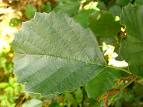Alnus Incana Subsp Rugosa Tree Information
Images of Alnus Incana Subsp Rugosa:






Alnus Incana Subsp Rugosa grows in the following 31 states and provinces:
Alberta, British Columbia, Connecticut, Delaware, Illinois, Indiana, Iowa, Kentucky, Maine, Manitoba, Maryland, Massachusetts, Michigan, Minnesota, New Hampshire, New Jersey, New York, Northwest Territories, Nova Scotia, Ohio, Ontario, Pennsylvania, Prince Edward Island, Rhode Island, Saskatchewan, South Dakota, Vermont, Virginia, West Virginia, Wisconsin, YukonInformation about Alnus Incana Subsp Rugosa:
The Alnus Incana Subsp. Rugosa is commonly known as the European Speckled Alder, Gray Alder, Hazel Alder, Hoary Alder, Mountain Alder, Speckled Alder as well as Tag Alder.
The currently accepted scientific name for speckled alder is Alnus incana (L.) Moench subsp. rugosa (Du Rois) Clausen . LIFE FORM : Tree, Shrub FEDERAL LEGAL STATUS : No special status OTHER STATUS : NO-ENTRY DISTRIBUTION AND OCCURRENCE SPECIES: Alnus incana subsp. rugosa Speckled alder is most common in the region surrounding the Great Lakes and the St. Lawrence Seaway, including east-central Canada, the Maritime Provinces, and the Northeast and Lake States. It is listed as the most prominent (in biomass) understory shrub in Michigan's Upper Peninsula . In addition, speckled alder occurs sporadically throughout all the remaining Canadian provinces and south along the Appalachian Mountains to West Virginia and Maryland. It is restricted to higher elevations at the southern limit of its range . Speckled alder is frequently found in riparian, bog, and nutrient-rich swamp communities . It often dominates the understory shrub layer in lowland stands of balsam fir (Abies balsamea), red spruce (Picea rubens), northern white-cedar (Thuja occidentalis), red maple (Acer rubrum), jack pine (Pinus banksiana), tamarack (Larix laricina), balsam poplar (Populus balsamifera), aspen (Populus spp.), birch (Betula spp.), and black spruce (Picea mariana) . Other associates include cinnamon fern (Osmunda cinnamonea), high-bush blueberry (Vaccinium corymbosum), Sphagnum spp., and Carex spp. . Published classification schemes that list speckled alder as a dominant in community types (cts) or plant associations (pas) include: Area Classification Authority NF forest cts Damman 1964 PQ: St.Lawrence Valley general veg. pas Dansereau 1957 MANAGEMENT CONSIDERATIONS SPECIES: Alnus incana subsp. rugosa Some of the information provided here is attributed to:Van Deelen, Timothy R. 1991. Alnus incana subsp. rugosa. In: Fire Effects Information System, [Online]. U.S. Department of Agriculture, Forest Service, Rocky Mountain Research Station, Fire Sciences Laboratory (Producer). , available at the USDA Fire Effects Information System (FEIS) website